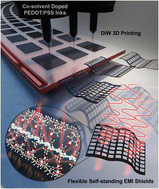3D printing of solvent-treated PEDOT:PSS inks for electromagnetic interference shielding†
Abstract
3D printing of conductive polymers has been achieved very recently by direct ink writing of poly(3,4-ethylenedioxythiophene):polystyrene sulfonate (PEDOT:PSS)-based inks. This field is in its infancy, calling for further research to broaden the application horizon of 3D-printed conductive polymers by fine-tuning their inherent properties. Indeed, engineering PEDOT:PSS inks with customizable electrical properties while keeping their rheological fingerprint within the proper range for high-fidelity 3D printing is an arduous challenge, yet to be achieved. Herein, a range of PEDOT:PSS-based inks are formulated by molecular engineering via co-solvent doping and solvent post-treatment with various solvents for high-resolution (line width and thickness variations less than 20% from average values), high-aspect-ratio (≥25 layers) 3D printing. Via a simple dry-annealing technique, rationally patterned flexible, self-standing, and geometry-friendly samples featuring a wide range of conductivity, i.e., from 0.6 to 858.1 ± 60.8 S cm−1, are fabricated. The results showed that the 3D-printed samples are wet-transferable onto uneven substrates and complex objects with sharp edges. By exploiting their tunable molecular-scale chemistry and macro-scale geometrical features, the 3D-printed devices were used to create advanced electromagnetic shields with controlled mechanisms.

- This article is part of the themed collections: Journal of Materials Chemistry A Emerging Investigators and #MyFirstJMCA


 Please wait while we load your content...
Please wait while we load your content...